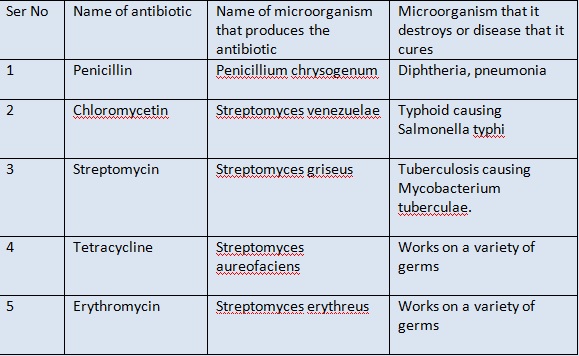Microorganisms
Organisms that are very small in their shape are called as microorganisms. These microorganisms are microscopic or some of them cannot be seen even under a compound microscope.
There are different types of microorganisms. These include viruses, bacteria, viruses, algae, fungi, yeast cells and Protozoa.
Viruses
These are very small. They can be studied only under an electron microscope. A virus is a simple structure. It has a protein coat and genetic material such as Deoxy ribose nucleic acid (DNA) or Ribose nucleic Acid (RNA). Viruses cannot live independently. They need an organism to multiply in numbers. Viruses are specific to their hosts. Various plant and animal viruses are known to us.
Bacteria
Bacteria are visible under the microscope with a magnification of 100X. Bacteria are larger than the viruses. Bacteria based on their shapes can be classified into four types–bacilli (rods), Cocci (spheres), Vibrio’s and spirillum. Bacteria come in a wide variety of shapes: A. Rod–shaped B. Round–shaped or spherical. C. Round–shaped in clusters. D. Round–shaped twos. E. Spiral–shaped. F. Comma–shaped.
Useful bacteria
- Rhizobium bacteria found in the root nodules are nitrogen fixing (Nitrogen providing) bacteria. They convert the nitrogen from the soil into nitrates and nitrites and help the plants to grow better. These compounds of nitrogen make the soil fertile.
- Bacterium called Azotobacter that is found independently in the soil with- out the association with plants also fixes nitrogen.
- Soil has several bacteria that cause decomposition of the dead and decay- ing organisms. They help the recycling of the products back to nature. They thus increase the fertility of the soil.
- Bacteria like Escherichia coli are found in the gut of human beings .These bacteria help us to synthesize vitamin K.
Harmful bacteria
- Some bacteria act as pathogens and cause tetanus, typhoid fever, pneu- monia, syphilis, cholera, food borne illness and tuberculosis.
- Sepsis, a systemic infectious syndrome characterized by shock and massive vasodilatation, or localized infection, can be caused by bacteria such as streptococcus, staphylococcus, or many gram-negative bacteria.
- Some bacterial infections can spread throughout the host’s body and be- come systemic.
- In plants, bacteria cause leaf spot, fireblight, and wilts. The mode of infection includes contact, air, food, water, and insect-borne microorganisms. The hosts infected with the pathogens may be treated with antibiotics, which can be classified as bactericidal and bacteriostatic, which at specific concentrations that can be reached in bodily fluids either kill bacteria or hamper their growth, respectively.
- Bacteria like clostridium can grow on the food stuff which is beyond a time limit (we call it an expiry date). These bacteria produce toxins, when eaten and can cause diarrhea and food poisoning. It is for this reason expiry date of the product must be checked before purchase.
Algae
These are found in wet and damp places. These have chlorophyll. These are autotrophic. Some algae serve as food. If a river has too much of nutrients the rivers show a full growth of algae. These are called as algal blooms. These blooms give a bad taste to water. Algal growth I overhead water tanks also are algae of the similar type. Diatoms are a kind of unicellular algae. Other examples are Volvox, Anabena, Chlorella, Spirogyra.
Fungi
Fungi are non photosynthetic organisms. They are found to live on decomposing materials. Some of them are parasitic. Some fungi are useful while some are harmful.
Useful fungi
Penicillium a kind of fungus produces certain substances called ’antibiotics’. These are used to treat bacterial infections. There are various microorganisms that provide us a variety of antibiotics. These drugs have saved lacs of lives.
Antibiotics

Yeast cells
Yeast is a member of class fungi. It is used in process of fermentation. Bread, idli dosa batter, dhokla batter, alcohol production is done with the help of yeast. These help development of taste to the material. Sometimes unpalatable tastes too may be developed by yeast cells.
Protozoa
These are unicellular animals without chlorophyll. Protozoa can be harmful or harmless to human beings. Some diseases caused by protozoa are as follows :

